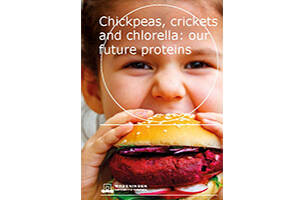Mansholt Lecture: Snapshots of European food systems in 2050
The fourth edition of the Mansholt Lecture has taken place in Brussels on Wednesday 18 September 2019. This year the Mansholt Lecture addressed the challenges of future protein production and consumption.

Wageningen UR calls for a new focus on production and consumption. They envision a future in which protein production will need to be sustainable, affordable and healthy. Purposeful combinations of plants, animals, and microorganisms from land and sea will be tailored to local conditions, even where resources are scarce. Global consumption patterns will shift to a more diverse and equitably shared portfolio of sources. Breakthrough innovations, societal shifts, and supportive regulatory changes are therefore required.
In the brochure Chickpeas, crickets and chlorella: our future proteins, published as an introduction for the Mansholt Lecture, WUR gives four snapshots of European food systems in 2050:
1. What do we eat?
European consumers enjoy a diet primarily based on whole foods from a variety of sources. Pulses like fava beans and grains like quinoa are combined to form a solid nutritional basis for most meals. These are complemented by occasional consumption of a variety of new protein sources: water-based plants like duckweed and kelp; plants cultivated on marginal lands like sea buckthorn and cactus; and bacterial and fungal biomass like mycoprotein. Animal protein consumption from a mixture of meat, fish, dairy, eggs, and new species of animals is on average 10 kg per person per year or about 28g per day. Local circular greenhouses integrate protein production with fresh fruit and vegetable cultivation, leading to increased access to and consumption of fresh foods.
2. How is our food sourced, processed, and distributed?
Europe maintains a strong global trade position based sustainable innovations in agriculture. Protein imports and exports are in balance. The total energy footprint of the European agri-food system has been drastically reduced by technological breakthroughs in food processing. A rich variety of new and traditional food products is available, based on minimally-refined plant sources. Food distribution systems are optimized so that no food is wasted; circular production systems upcycle industrial side streams and post-consumer waste through animal protein production. The digital revolution has enabled harmonization of supply and demand.

3. What do we eat from the sea?
Oceanic farms which combine green energy production and protein production can be seen from much of the European coastline. After a period of reduced fishery catch designed to enable oceanic ecosystems to recover, the open sea fish numbers have increased and Europe’s oceanic resources again provide a rich source of proteins and omega-3 fatty acids to the population. Supplemental fish protein is produced through sustainable aquaculture based on feed from algae, seaweed, and industrial side streams.
4. How does the land look?
The European landscape includes a more diverse collection of protein-rich crops, based on a flourishing ecosystem of pulse production and a variety of plants growing on lands typically not considered prime farm lands. Food production and recreation co-exist in biodiverse food forests and coastal areas. The total number of ruminant animals is reduced and cattle are grazed on marginal lands planted with deep-rooted perennial plants. Pigs and insects are fed primarily with post-consumer waste streams.